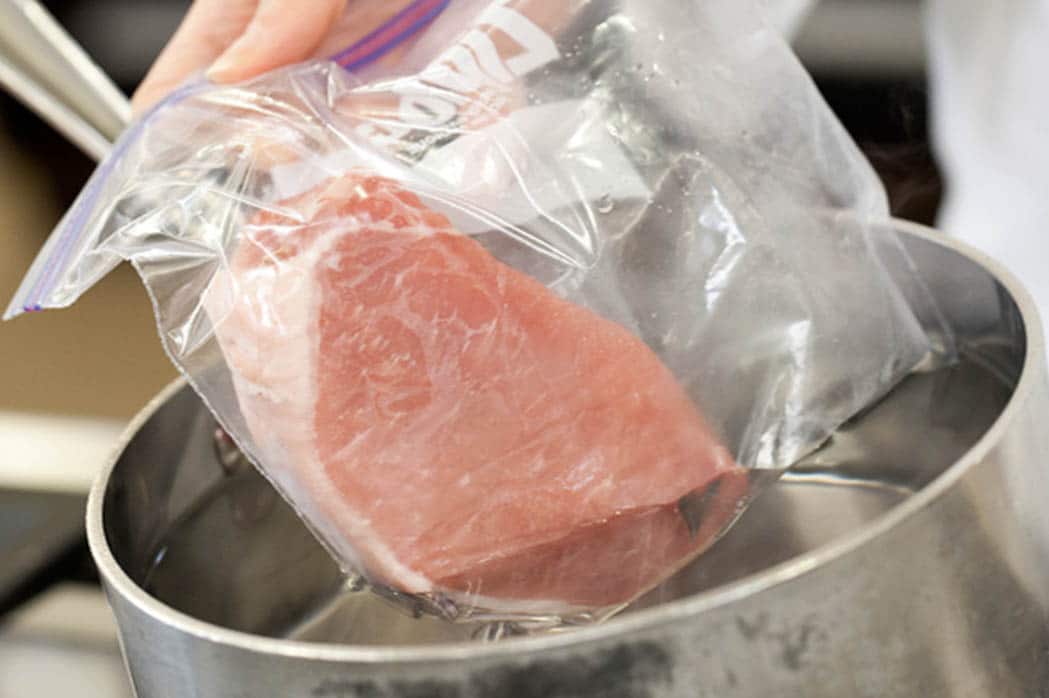Domestic Details: How to Safely Defrost Meat
This post may contain affiliate links. Read about my affiliate policy.
 When it comes to storing food, keeping it in the freezer is a no-brainer. Honestly, I’m incredibly proud of my “freezer of surprises,” which at any given time is stocked with everything from soups and muffins to turkey sausages and steaks. (My roommate also stores a pizza in there for “emergencies.”) While you don’t have to be quite so aggressive, I strongly suggest keeping a few frozen essentials on hand for the days when you can’t make it to the grocery store or are in need of a quick meal. Do it.
When it comes to storing food, keeping it in the freezer is a no-brainer. Honestly, I’m incredibly proud of my “freezer of surprises,” which at any given time is stocked with everything from soups and muffins to turkey sausages and steaks. (My roommate also stores a pizza in there for “emergencies.”) While you don’t have to be quite so aggressive, I strongly suggest keeping a few frozen essentials on hand for the days when you can’t make it to the grocery store or are in need of a quick meal. Do it.
Luckily, most people seem to be pretty clear on how to freeze things (i.e. put food in airtight packaging, open freezer, insert food, close freezer), but there appears to be some serious confusion surrounding defrosting, especially when it comes to meat. Sure, you can take a couple cupcakes out of the freezer in the morning, put them on the counter, and then eat them when you get home from work 12 hours later. I can’t say the same for a rack of lamb, which would become a bacterial freakfest in that amount of time. So, for the sake of knowledge and your health, I have outlined the only three methods you should be using to safely thaw your meat. You’re welcome.
The 3 Safest Ways to Defrost Meat:
1. In the fridge. This is hands-down the safest method for defrosting any type of meat. In terms of timing, allow roughly 24 hours for every 5 pounds. (A giant roast or Thanksgiving turkey may need up to 3 days of chillaxing in the fridge before it fully thaws.) Needless to say, defrosting meat in this way requires some planning, which isn’t always possible. What if you decide to make something awesomely domestic on a whim and you need to defrost a couple chicken breasts ASAP? Don’t panic, that’s where the next two methods come in.
2. In the microwave. Defrosting meat in the microwave is a double-edged sword my friends. Yes, this method is definitely the fastest, but it also carries the most risk. The problem is that your meat will actually start to cook in the microwave, and partially cooked meat is the frat house of bacterial environments. Things get weird. If you must use your microwave to defrost, make sure that you cook the meat immediately afterwards. No cocktails and chit-chat, capiche?
3. In a cold water bath. This is my go-to method, since I’ve never been described as a “planner.” Put your meat in a sealed bag with as much air removed as possible, and submerge it in a sink or bowl filled with cold water. Make sure you replace the water every 30 minutes until the meat is thawed in order to maintain a constant temperature. (You can also leave your sink running in a thin stream over the submerged meat to keep the water circulating, but I will leave that decision up to you, as I don’t wish to anger any water conservationists.) Using this method, you should be able to defrost most small pieces of meat (i.e. sausages, chicken cutlets and thin chops) in about half an hour, and a thicker cut in about an hour. Booyah.
I’m sure some of you are thinking, “Serena, can’t i just use warm or hot water to speed up this process?” No, you may not. Warm water will raise the temperature of the meat into the bacterial “danger zone,” which is a scary place, people. Will you get food poisoning if you defrost a chicken breast in hot water? Probably not, but I wouldn’t recommend rolling the dice. Trust me.
Domesticity is all in the details, friends. Bow to your sensei.
*If you have a burning question that you’d like featured on a future edition of Domestic Details, don’t hesitate to contact me or leave it in the comments. Help me help you.
Image via.
Shop this post
Never miss a post!
Get new recipes and lifestyle tips delivered straight to your inbox.
